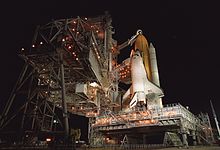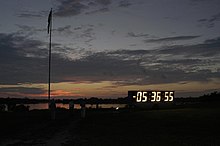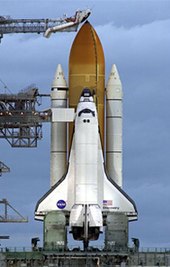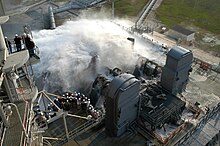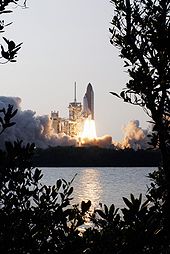Countdown (Space Shuttle)
The most important tasks that had to be performed during a countdown for a space shuttle launch are listed below, along with the associated phase and approximate duration.
Preparations
Preparations for a shuttle flight began with securing the orbiter and the eventual transport back to the Kennedy Space Center , should the previous landing take place elsewhere, for example at Edwards Air Force Base . He was then taken to an Orbiter Processing Facility (OPF).
Two to three months before the launch, the assembly of the space shuttle system began with the assembly of the two solid fuel rockets on a launch platform in the Vehicle Assembly Building (VAB). The external tank was then positioned and fastened between the solid rocket rockets.
About five weeks before the launch, the orbiter was rolled by the OPF into the VAB and attached to the external tank. At around the same time, the payloads for the payload bay were driven to the launch facility . The rollout of the space shuttle to the launch pad took place around a month before the launch. It was there that most of the payloads and equipment were placed in the orbiter over the next three weeks. The crew arrived at the Kennedy Space Center one day before the countdown began. After a call to stations from the test leader, the countdown clock was started.
countdown
T-41 h and counting
The phase lasted 16 hours. (Time to start L-69: 10 h)
- The last vehicle and building safeguards have been initiated.
- The backup flight system has been checked.
- The flight software in the main memory and the displays have been checked.
- The backup flight system software has been loaded onto the main computer.
- The working platforms in the flight deck and middle deck have been removed.
- The navigation system has been activated and checked.
- The preparation of the energy distribution system has been completed.
- The preparations for the flight deck inspections have been completed.
T-27 h and holding
The phase lasted 4 hours (L-53: 10 h).
- The personnel no longer needed left the launch pad.
T-27 hours and counting
The phase lasted eight hours (L-49: 10 h).
- The loading of the storage tanks for the OMS engines began.
T-19 h and holding
The phase lasted 4 hours (L-41: 10 h).
- Some scaffolding in the middle part of the shuttle was dismantled.
T-19 hours and counting
The phase lasted 8 hours (L-37: 10 h).
- The main engines were prepared for refueling and flight.
- The sound containment system was filled with water.
- The orbiter and ground support equipment was checked.
- Several masts were stowed on the mobile launch platform.
T-11 h and holding
The phase lasted up to 13 hours (L-29: 10 h).
- The last items of crew equipment have been stowed away.
- The RSS maintenance platform (Rotating Service Structure) has been moved to the parking position.
- The orbiter's internal measurement and communication systems have been activated.
- The cockpit has been configured for start.
T-11 hours and counting
The phase lasted 5 hours (L-16:10 h).
- The orbiter's tanks have been activated.
- The unneeded personnel left the danger zone.
- The orbiter's air has been replaced with nitrogen to purge it .
T-6 h and holding
The phase lasted two hours (L-11:10 h).
- The flight control received an updated weather report.
- The start team confirmed that there were no problems with the start criteria before the outer tank was filled.
- The entire staff left the launch pad.
- The fuel transfer lines were cooled down.
- The outer tank was filled with two million liters of liquid fuels (hydrogen and oxygen).
T-6 h and counting
The phase lasted three hours (L-9:10 h).
- The filling of the external tank has ended.
T-3 h and holding
The phase lasted 2 hours (L-6: 10 h).
- The measuring units were calibrated for the pre-flight phase.
- The Merritt Island tracking antenna has been aligned.
- A team inspected the shuttle from the outside one last time.
- The closeout crew, who are responsible for the safe entry of the astronauts and the locking of the access hatch, went to the launch pad to prepare the orbiter and the white room for the astronauts.
T-3 h and counting
The phase lasted 2 hours and 40 minutes (L-4: 10 h).
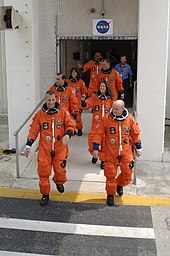
- The crew went to the launch pad and boarded the orbiter via the white room.
- Preparations to close the orbiter began.
- The switch positions in the cockpit have been checked.
- The astronauts carried out comchecks with the launch, mission and possibly other control centers.
- The orbiter was locked and the hatch checked for leaks.
- The White Room has been secured and abandoned.
- The closeout crew went to a fallback area in order to be able to react quickly in the event of an abort.
T-20 min and holding
The phase lasted 10 minutes (L-1: 30 h).
- The Shuttle Test Director informed the start team one last time.
- The unit of measure calibrations have ended.
T-20 minutes and counting
The phase lasted 11 minutes (L-1: 20 h).
- The orbiter computers have been configured for launch.
- The fuel supply was regulated.
- The exhaust air valves in the crew cabin were closed.
- The backup flight system was prepared for take-off.
T-9 min and holding
The duration of this phase depended on the mission, but was about an hour long (L-1: 09 h).
- The flight and take-off directors asked their teams to be ready to take off (GO / NO-GO survey).
T-9 minutes and counting
The phase lasted 9 minutes (L-0:09 h).
- The automatic ground start sequencer has started.
- The orbiter arm retracted at T-7:30 minutes.
- The three APUs start at T-5:00 minutes.
- The SRB's target area has been secured.
- The air surface profile tests and the movement tests of the SSMEs started at T-3: 55 minutes.
- The vent arm was caught at T-2:55.
- The crew closed their visors at T-2:00 minutes.
- The orbiter switched from ground to internal power at T-55 seconds.
- At T-31 seconds, the automatic start sequencer got the GO to start. Up to this point in time, the countdown could be stopped and canceled by the start control, after which the start could only be prevented by automatically switching off the main engines.
- The noise reduction system was activated at T-16 seconds and sprayed more than 1 million liters of water under the engines in 41 seconds to prevent damage from sound waves.
- At T-10 seconds, the burn-off system began to spark off.
- The main engines started working at T-6.6 seconds.
T-0
- The two solid rockets were detonated, the explosive bolts for fastening the solid rocket on the launch platform were blown and the space shuttle took off.
After the start
- Mission control took over the flight after the spacecraft left the launch tower.
- The roll maneuver, which aligned the shuttle for the planned orbit, was also carried out shortly after leaving the launch tower.
- The SRBs were dropped two minutes after takeoff. They were later recovered from the Atlantic.
- The main engines were switched off about eight minutes after take-off.
- Ten seconds later, the external tank was dropped.
- The crew received the GO for on-orbit activities.
- The OMS engines were fired for the first time to achieve a stable orbit.
- The cargo hold doors were opened 1.5 hours after take-off.
- Six hours after takeoff, the orbiter was fully airworthy, the SRB were towed back to the Kennedy Space Center , and the external tank had burned up in the atmosphere.
swell
- NASA Countdown 101 (English)
- NASA Countdown in detail (English)

